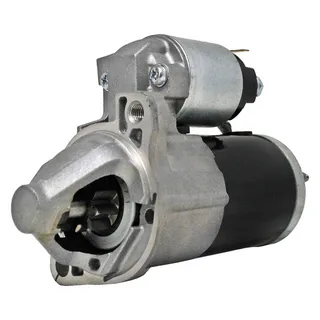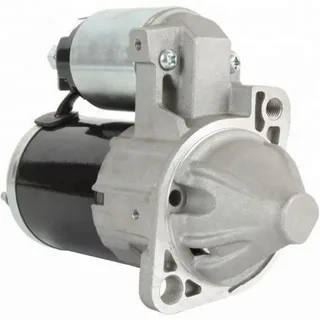If you own a Mitsubishi Outlander, you are likely familiar with the importance of regular maintenance to keep your vehicle running smoothly. One crucial component that deserves attention is the Mitsubishi Outlander Starter Motor. In this comprehensive guide, we will delve into the function of the starter motor, explore common issues, offer troubleshooting tips, and provide guidance on maintenance and upgrades. Whether you’re a seasoned car enthusiast or a beginner, this guide will equip you with the knowledge to ensure your starter motor operates efficiently.
Understanding the Function of a Starter Motor
The starter motor is a critical component in an automobile’s starting system. Its primary role is to initiate the engine’s operation by converting electrical energy from the battery into mechanical energy. This mechanical energy is crucial for cranking the engine, enabling it to start.
How the Starter Motor Works
When the driver turns the ignition key or presses the start button, an electrical signal is sent from the battery to the starter motor. This signal activates the motor, causing it to rotate a pinion gear that engages with the engine’s flywheel. This engagement allows the starter motor to turn the engine over, effectively starting the combustion process.
Importance of the Starter Motor
The starter motor’s efficiency is vital for reliable vehicle operation. If it fails, the engine will not crank, leaving the vehicle inoperable. Common issues affecting the starter motor include wear and tear, faulty wiring, or a weak battery. Regular maintenance checks can help identify problems early, ensuring the starter motor functions appropriately.
In summary, the starter motor is an essential component in starting an engine. Understanding its function helps car owners appreciate the importance of regular maintenance and the need for timely repairs to avoid unexpected breakdowns. This knowledge can ultimately lead to a more reliable and efficient driving experience.
Common Issues with Mitsubishi Starter Motors
Mitsubishi starter motors are integral to the vehicle’s functionality, providing the necessary power to start the engine. However, like any automotive component, they can experience various performance issues. Understanding these common problems can help owners recognise symptoms early and seek appropriate repairs or replacements.
One prevalent issue with Mitsubishi starter motors is the failure to engage. This can manifest as a clicking sound when the ignition is turned, indicating that the starter motor is not engaging with the flywheel. Often, this is due to a weak battery, corroded connections, or a faulty solenoid. Regularly checking the battery’s health and ensuring clean, secure connections can mitigate this issue.
Another common problem is intermittent starting. This occurs when the starter motor functions inconsistently, sometimes starting the engine without issue and others failing. This inconsistency can be frustrating and is often caused by worn brushes or a failing armature within the starter motor. Owners should consider having their starter motor inspected if they notice this behaviour, as it may indicate that the motor is nearing the end of its lifespan.
Overheating is also a concern for Mitsubishi starter motors, particularly in older models. Excessive heat can damage the motor’s components, such as the windings and bearings, ultimately failing. This overheating can stem from prolonged cranking of the engine, a faulty ignition switch, or inadequate ventilation around the starter motor. It is crucial to promptly address any overheating signs to prevent further damage.
Regular maintenance, including checking battery health, cleaning connections, and inspecting starter motor components, can help prolong the life of Mitsubishi starter motors and ensure reliable performance. Recognising these common issues early allows timely intervention, enhancing the vehicle’s overall reliability.
Tips for Troubleshooting Starter Motor Mitsubishi Outlander
Troubleshooting a starter motor problem in a Mitsubishi Outlander can be straightforward if you follow a systematic approach. The starter motor is crucial for initiating the engine’s operation, and its issues can lead to frustrating situations. Here are some tips to help you effectively diagnose and resolve starter motor problems.
1. Check the Battery
The first step in troubleshooting Starter Motor Mitsubishi Outlander issues is to inspect the battery. A weak or dead battery is often the primary culprit behind starting problems. A multimeter measures the battery voltage; it should read around 12.6 volts when fully charged. If the voltage is below 12 volts, consider jump-starting the vehicle or replacing the battery. Also, check the battery terminals for corrosion and ensure they are tightly connected.
2. Inspect the Starter Relay and Fuse
Next, examine the starter relay and fuse. The relay is responsible for sending power to the starter motor. Refer to your owner’s manual for the starter relay location and fuse in your Outlander. Check for continuity using a multimeter; if the relay is faulty, it should be replaced. Additionally, inspect the fuses to ensure none are blown, as a blown fuse can interrupt the power supply to the starter motor.
3. Test the Starter Motor
If the battery and relay function properly, it’s time to test the starter motor. Locate the starter motor, which is typically found near the engine block. Use a multimeter to check for power at the starter terminal when the key is turned to the start position. The issue may lie within the ignition switch or wiring if there is no power. If there is power but the starter motor does not engage, it may need replacement.
4. Examine the Wiring
Lastly, inspect all wiring associated with the starter motor for signs of wear or damage. Frayed wires can cause intermittent connections and lead to starting issues. Ensure that all connections are secure and free of corrosion.
Following these steps, you can systematically troubleshoot starter motor issues in your Mitsubishi Outlander and restore your vehicle’s reliability.
Maintenance Tips for the Starter Motor
The starter motor is a crucial component of your vehicle’s starting system. Proper maintenance can prolong its lifespan and ensure reliable performance. Here are some essential tips to keep your starter motor in optimal condition.
Regular Inspections
Conduct regular inspections of the starter motor and its connections. Look for signs of wear, corrosion, or loose connections, which can lead to starting issues. Ensure the battery terminals are clean and securely attached, as a weak battery can strain the starter motor.
Keep the Battery Charged
A fully charged battery is essential for a starter motor’s performance. Check and maintain the battery’s charge regularly, especially in extreme weather conditions. Consider replacing an old or weak battery to avoid unnecessary strain on the starter motor.
Listen for Unusual Noises
Pay attention to any unusual noises when starting your vehicle. Grinding, clicking, or whirring sounds can indicate problems with the starter motor or other components. If you hear any strange noises, it’s essential to have the system checked by a professional.
Ensure Proper Lubrication
Some starter motors have moving parts that require lubrication. Check the manufacturer’s recommendations for lubricating components and apply the appropriate lubricant to ensure smooth operation.
Professional Servicing
Schedule regular maintenance with a qualified technician. They can perform comprehensive diagnostics, identify potential issues, and ensure that your starter motor and the entire starting system are functioning correctly. Regular servicing can prevent more significant problems down the road.
Upgrading Your Outlander Starter Motor
Upgrading the starter motor in your Mitsubishi Outlander can enhance its reliability and performance, especially if you notice sluggish starts or unusual noises. A new starter motor can provide a more efficient power transfer, ensuring your engine starts smoothly every time.
Signs You Need an Upgrade
Before proceeding with an upgrade, it’s essential to recognise the signs that indicate a failing starter motor. Common symptoms include a clicking sound when turning the key, slow cranking, or no response at all. If you experience any of these issues, it may be time to consider an upgrade.
Choosing the Right Starter Motor
When selecting a new starter motor, ensure compatibility with your specific Outlander model and engine type. Look for high-quality OEM (Original Equipment Manufacturer) parts or reputable aftermarket options. A high-performance starter can also provide faster cranking speeds, which can be beneficial in cold weather or high-performance applications.
Installation Process
Upgrading the starter motor is straightforward and can be tackled with basic tools. First, disconnect the battery to prevent electrical shorts. Then, remove the old starter motor, typically located near the transmission. Follow the manufacturer’s instructions for installing the new motor, ensuring all connections are secure.
Choosing the Right Starter Motor
Selecting the correct starter motor for your vehicle ensures reliable starting performance. A starter motor is an essential component of your vehicle’s ignition system, converting electrical energy from the battery into mechanical energy to start the engine. Several factors should be considered when choosing a starter motor to ensure compatibility and optimal functionality.
First and foremost, it is essential to know your vehicle’s specifications. The starter motor must match your vehicle’s make, model, and engine size. Using an incompatible starter motor can lead to poor performance or even damage to the engine. Checking the vehicle’s service manual or consulting a knowledgeable mechanic can provide insights into the correct specifications needed for your starter motor.
Another factor to consider is the type of starter motor. There are generally two types: permanent magnet and series wound. Permanent magnet starters are typically lighter and more compact, making them suitable for smaller engines. In contrast, series wound starters are more robust and can handle larger engines, providing greater torque. Understanding the differences between these types will help you select a starter motor that suits your vehicle’s performance requirements.
Additionally, consider the brand and quality of the starter motor. Reputable manufacturers often provide better reliability and warranty options. Investing in a high-quality starter motor may save you from frequent replacements and costly repairs in the long run. Reviews and recommendations from other vehicle owners can also guide you in choosing a reliable product.
Lastly, always verify the warranty and return policy when purchasing a starter motor. This ensures you have options if the part does not fit or perform as expected. By carefully considering these factors, you can choose the suitable starter motor that enhances your vehicle’s starting efficiency and longevity.
Conclusion
Proper maintenance of the Mitsubishi Outlander Starter Motor is essential for the vehicle’s reliability. Recognising symptoms like clicking or grinding noises and addressing them early can prevent costly repairs. Regularly check electrical connections and ensure the battery is in good condition to support the starter motor’s function. Upgrading the starter motor can provide performance benefits, but selecting one compatible with your Outlander model that meets your specific needs is crucial. Always consult with an automotive specialist to ensure you make an informed choice. Maintaining your starter motor through routine checks and minor maintenance can significantly extend its lifespan.
FAQS
Q: How often should I inspect my Mitsubishi Outlander Starter Motor?
A: Including the Mitsubishi Outlander Starter Motor in your routine vehicle maintenance is advisable, typically every 6-12 months. Keep an ear out for unusual noises during startup, as these can signal potential issues that warrant a closer inspection.
Q: Can I replace the starter motor myself?
A: While it’s feasible for those with mechanical skills, replacing a starter motor can be complex and may require specialised tools. To ensure proper installation and avoid potential issues, it’s generally recommended to have a professional mechanic perform the replacement.
Q: What should I do if my Outlander won’t start, and I suspect the starter motor?
A: Start by checking the battery voltage and inspecting the electrical connections for any signs of corrosion or looseness. If everything appears in order but the vehicle still won’t start, consult a professional for a thorough diagnosis to determine whether the starter motor or another component is at fault.
| Other Good Articles to Read |
| Cme Blog Spot |
| Garcias Blogs |
| Yyc Blogs |
| Guiade Blogs |
| Blogs-Hunt |
| Impact-Blog |
| Smarty Blogs |
| Ed Blog |
| Mo Blogs |
| Blogs Em |
| Blog St |
| Related Business Listings |
| Contact Directory |
| Local Business Profiles |

